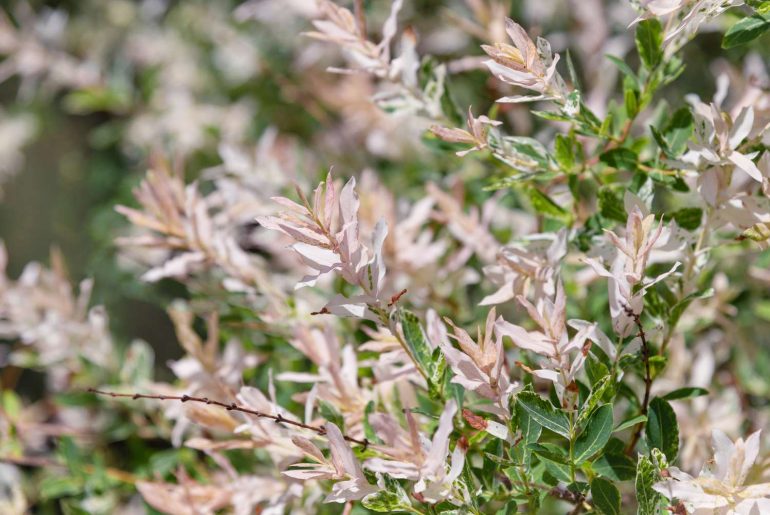The popular dwarf willow known as the flamingo tree (Salix integra ‘Hakuro-nishiki’) is known for its springtime foliage. In the summer, the leaves turn green, and in the fall, when they drop, coral-orange stems emerge. Yellow catkins appear before the spring foliage returns.
The small tree or shrub Salix integra “Hakuro-nishiki” is compact. It is frequently sold as a standard or lollipop tree grafted onto a different variety of willow rootstock. The Royal Horticultural Society gave it the prestigious Award of Garden Merit, which makes it a great choice for smaller gardens.
In full sun or partial shade, cultivate Salix integra “Hakuro-nishiki” in soil that is moist but well-drained. As long as they get enough water, standard trees do well in a pot. If desired, prune lightly in the summer and winter.
Despite its delicate appearance, the flamingo tree is completely hardy in the UK. The Royal Horticultural Society has given it the prestigious Award of Garden Merit.
The Salix integra, commonly known as the dwarf willow, is a stunning ornamental shrub that can add unique beauty to gardens. With its gracefully arching stems and vibrant colored foliage, the Salix integra provides fabulous visual interest through the seasons. While relatively easy to grow, the Salix integra does require proper care and maintenance to thrive. Let’s explore some key tips for successfully caring for a Salix integra in your landscape.
Selecting the Right Location
-
Salix integra prefers full sun to partial shade Make sure to choose a spot that receives at least 6 hours of direct sunlight per day for best growth
-
Well-drained soil is essential. The roots of the Salix integra demand constant moisture but dislike soggy feet. Select a site with loamy soil that drains well after rain.
-
Give the Salix integra plenty of space. Depending on the variety, it can reach 6-10 feet tall and wide at maturity. Allow enough room for the shrub to reach its full size.
Planting Your Salix Integra
-
Spring is the ideal time to plant your Salix integra when the soil has warmed but before hot summer weather arrives.
-
Dig a hole twice as wide as the root ball. Loosen the soil at the bottom and mix in compost or organic matter to improve drainage.
-
Carefully place the shrub in the hole, keeping it at the same level it was growing in the nursery pot Backfill with soil and water thoroughly
-
Spread 2-3 inches of mulch around the base to retain moisture and reduce weeds. Leave space between mulch and stems.
Providing Consistent Irrigation
-
Salix integra is native to stream banks and requires consistent moisture. Water deeply once a week if rain is lacking.
-
Increase watering during summer heat. Prioritize watering if drought occurs. Use a soaker hose or drip irrigation.
-
Container grown Salix integra need more frequent watering, even daily. Check soil moisture regularly and don’t allow pots to dry out.
-
Add moisture retaining mulch yearly and apply water to the root zone rather than overhead.
Feeding Your Shrub
-
Fertilize Salix integra each spring with a balanced organic fertilizer or a slow-release product for ornamentals.
-
Avoid high nitrogen formulas which can promote leggy growth. Focus on even feeding.
-
For potted specimens, apply a water soluble fertilizer monthly during the growing season.
-
Mulch with compost annually to provide nutrients over time as it breaks down.
Pruning for Best Form
-
Prune Salix integra in early spring before growth starts to shape and invigorate the plant.
-
Remove dead, damaged or crossing branches using sharp bypass pruners. Cut back to just above an outward facing bud.
-
Thin inner stems to open up airflow and light penetration into the center of the shrub.
-
Renewal pruning can be done every 2-3 years if the shrub becomes overgrown. Cut all stems back by 1/3 their height.
-
For dwarf cultivars under 3 feet tall, shearing into a neat ball shape is effective.
Preventing and Controlling Pests
-
Salix integra is relatively pest resistant but aphids, scale, and spider mites can sometimes be a problem.
-
Rinse aphids off with a strong spray of water. For other pests, use appropriate organic insecticidal soap.
-
Promote healthy growth through proper culture. This helps the shrub better withstand and recover from pest damage.
-
Remove and destroy heavily infested parts. Monitor for signs of reinfestation and retreat if needed.
Watching for Disease Issues
-
Powdery mildew and leaf spots may affect Salix integra foliage, mainly in wet conditions. Improve air circulation and avoid overhead watering.
-
Remove affected leaves or stems if disease is severe. Rake and dispose of fallen debris promptly.
-
Preventive fungicide applications when disease first appears can help avoid spread. Use organic options for mild cases.
-
Disinfect tools between cuts when pruning diseased shrubs. Focus on promoting vigorous growth for resistance.
Overwintering Protection
-
Salix integra is quite cold hardy but some protection may be needed in zones 5 and below.
-
Wrap or surround the shrub with burlap in late fall. Top with evergreen branches for insulation if intense cold is expected.
-
Container grown specimens should be moved into an unheated garage or building once temperatures drop below freezing.
-
Water well before ground freezes. Mulch over the root zone to insulate roots from temperature extremes.
Enjoying Long-Lasting Beauty
Providing attentive care focused on moisture, drainage, feeding, and occasional pruning will keep your Salix integra looking its best for years of enjoyment. Take time to appreciate the graceful form, vibrant young foliage, showy stems, and multi-season interest of this remarkable ornamental shrub. A happy Salix integra will enhance your landscape with its natural elegance and delightful colors.
Caring for a Salix integra ‘Hakuro-nishiki’ (Flamingo Willow)
In dry weather, water ground-based plants. Keep the compost moist if you are growing a salix integra tree in a pot. In the spring, feed with a well-balanced fertiliser. Use well-rotted manure or garden compost as mulch in the spring to help keep the soil moist.
Cut back the growth by about a third to get lots of new pink leaves late in the winter and thick growth. Also get rid of any shoots that are growing in the wrong direction, are damaged, or are dying. Additionally, remove any sprouting shoots from the grafted stem by trimming it back. You can do a light trim again in the summer to get more new pink growth later in the season.
How to grow a Salix integra ‘Hakuro-nishiki’
Salax integra ‘Hakuro-nishiki’ should be grown in moist but well-drained soil that gets full sun or some shade. As long as they get enough water, standard trees do well in a pot. If desired, prune lightly in the summer and winter.

Plant your tree in full sun in moist, well-drained soil. It will look good in Japanese-style plantings as well as contemporary or urban gardens. Standards can also be grown in pots on the patio or along a doorway’s flanks.
First, dig a hole as deep as the rootball. Then, add a lot of compost or well-rotted manure to it. The rootball should then be placed in the hole with its surface level with the soil. Add soil to the hole. After planting, thoroughly water in and mulch to help retain moisture.
Use John Innes No. 3 compost that does not contain peat if you are growing a standard tree in a pot. As the plant gets bigger, move it into a bigger pot.
Flamingo Willow Salix With Peter McDermott
FAQ
How do you take care of Salix Integra?
Is Salix Integra sun or shade?
How much sun does Salix need?
How often do you water Salix?
- The Ultimate Guide to Growing Strawberries in Raised Beds - August 8, 2025
- No-Dig Garden Beds: The Easiest Way to Grow a Beautiful Garden - August 6, 2025
- How to Protect and Preserve Wood for Raised Garden Beds - August 6, 2025

